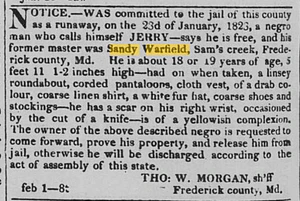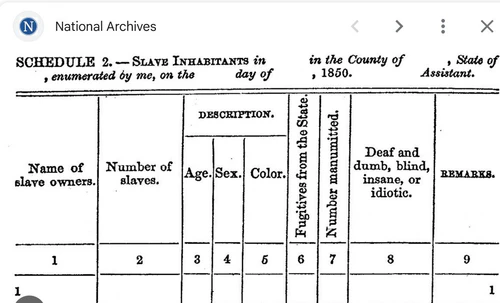While America’s ideals and Constitution[1], champion liberty and justice, its historical reality reveals deep contradictions. From the very beginning, America’s past included the unequal distribution of rights and power; purposeful annihilation of culture and heritage; the oppression, bondage, forced labor, exploitation and brutality of other races. For the enslaved African descended people, this can be seen in the Transatlantic Slave Trade[2]; laws and practices such as the Three-Fifth’s Compromise[3], Black Codes[4] and share cropping[5], each designed to control African descended people.
Enslaved people were denied control over their bodies, families, and future while destroying the family. Running away offered an opportunity for physical and emotional freedom; escape from profound dehumanization and brutality; and possible reuniting with loved ones.
Research your ancestors on MyHeritage
Avenues for Genealogical ResearchAvenues for Genealogical Research
Since enslaved people were valued for their free labor, any disruption in that labor resulted in economic instability or loss for the enslaver. Advertisements depicting runaways became common, highlighting the human spirit for freedom.

Newspapers carried notices of runaways, aiding genealogical research.
- Ads often contained information such as age, height, weight, name, special skill, enslaver and location.
- Sometimes multiple runaways from the same enslaver were listed in the same ad, their aliases, former enslavers and information on where they might be headed.
- Nearby waterways, forest or barren land might offer a clue to their escape route.
- Escape location could determine if north to a free state or Canada was likely or Mexico.
- Detailed descriptions of the enslaved often depict a picture of accident or brutality such as knife, whip or axe wounds, scars from the kick of a horse, even loss of limbs.
- Local sheriffs ran ads announcing the jailing of an accused runaway and made money for themselves and their communities by charging a fee for their release.

Though the 1850 and 1860 Slave Schedules[6] contained a column listing the number of runaways from a particular state, the documents are recorded by specific locations within a state with the name of the enslaver.
- A tick mark next to a specific description (age and sex) may be the clue needed to help understand what may have happened to an ancestor and signal additional research.
- Large numbers of runaways from a particular location may point to poor plantation management or correlate to the death of an enslaver which often generated chaos on the plantation creating opportunities for escape.
- It may also point to a strong underground railroad network in the area and assistance from abolitionists or sympathizers.
Abolitionists[7] and sympathizers played an important role.
- Abolitionist newspapers such as The Liberator[8] and The North Star[9] published stories of successful escapes, legal advice, and warnings about slave catchers. They also educated the public about the horrors of slavery, helping to shift public opinion and create safer environments for fugitives in the North.
- In more radical cases, abolitionists stormed jails to free captured runaways or organized resistance against slave catchers[10], as seen in the Christiana Riot[11] and Oberlin-Wellington Rescue[12].
Court Cases are rich with details about runaways and those accused of being runaways.
- It was not unusual for manumissions[13] in last wills and testaments not being honored after death causing enslaved individuals to sue for their liberty.
- Freedmen and women accused of being escaped slaves called upon their neighbors to vouch for them in court proceedings.
- Those assisting runaways were sometimes jailed or fined.
- Slave catchers operated in free states resulting in court cases to free their captives.
Other Examples of America's ContradictionsOther Examples of America's Contradictions
- In the 19th century, Chinese immigrants were brought to build the Transcontinental Railroad[14] under grueling, dangerous conditions with little pay and rampant discrimination.
- The Bracero Program[15] allowed temporary laborers from Mexico to work in the U.S., often resulting in exploitation, wage theft, and inhumane living conditions.
- Native Americans were enslaved during Spanish colonization and continued under American expansionism, with forced assimilation programs like Indian boarding schools[16], the stripping of culture, forced migration[17] and stealing of land[18].
- During World War II, over 120,000 Japanese Americans, many, U.S. citizens, were forcibly relocated and incarcerated in Japanese Internment camps[19] without due process. Driven by racial prejudice and wartime hysteria, nearly all of them lost their homes, belongings, communities and economic base.
ConclusionConclusion
America’s past is marked by a persistent pattern of systemic abuse rooted in power, profit, and control. Across generations, individuals from all walks of life, regardless of ethnicity, have struggled to escape oppression in pursuit of freedom and dignity.
Researching runaways is a great way to understand the economic and political climate at the time. For the African descended, every tally in the runaway column of the slave schedule represents someone who risked everything to reclaim their freedom, an act of courage that census data could never fully capture. Every escape attempt proved that slavery wasn’t just an economic system, it was oppression people actively resisted.
The act of running away helped to humanize the man, woman and child who was seen as ”less than” contradicting myths that enslaved people were “content” or “well-treated.” Individuals such as Henry “Box” Brown[20], Josiah Henson[21], Frederick Douglass[22], Ellen and William Craft[23], and Sojourner Truth[24], became living proof that escape was possible and that enslaved people could thrive in freedom.
See alsoSee also
Explore more about Slavery, runaways and genealogical researchExplore more about Slavery, runaways and genealogical research
- A Brief History of Japanese American Relocation. National Park Service
- What Happened on the Trail of Tears? National Park Service
- Indian Affairs: Laws and Treaties. Edmon Low Library.
References
- ↑ The Constitution of the United States | National Archives
- ↑ Transatlantic slave trade | History & Facts | Britannica
- ↑ The Three-Fifths Compromise: History and Significance
- ↑ Black Codes - Definition, Dates & Jim Crow Laws | HISTORY
- ↑ Sharecropping: Definition and Dates | HISTORY
- ↑ United States Census Slave Schedules • FamilySearch
- ↑ Abolitionists - Anti-Slavery Activists
- ↑ The Liberator | Newspaper, William Lloyd Garrison, Definition, History, & Facts | Britannica
- ↑ Search | Britannica
- ↑ Slave Catching and Kidnapping, and the Struggle for Social Justice | Hopkins Press
- ↑ Christiana Riot of 1851 | BlackPast.org
- ↑ The Oberlin-Wellington Rescue 1858 - Oberlin Heritage Center
- ↑ MANUMISSION Definition & Meaning - Merriam-Webster
- ↑ Transcontinental Railroad - Construction, Competition & Impact
- ↑ Home · Bracero History Archive
- ↑ The U.S. history of Native American Boarding Schools — The Indigenous Foundation
- ↑ Trail of Tears | Facts, Map, & Significance | Britannica
- ↑ American Indian Treaties | National Archives
- ↑ The Injustice of Japanese-American Internment Camps Resonates Strongly to This Day
- ↑ Henry "Box" Brown - Facts, Magician & Life
- ↑ The Story of Josiah Henson, the Real Inspiration for 'Uncle Tom’s Cabin'
- ↑ Frederick Douglass - Narrative, Quotes & Facts | HISTORY
- ↑ "A Desperate Leap for Liberty": The Escape of William and Ellen Craft (U.S. National Park Service)
- ↑ https://www.loc.gov/exhibits/odyssey/educate/truth.html

